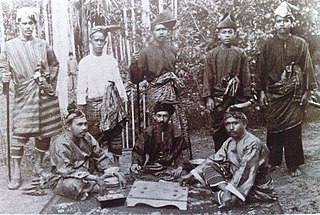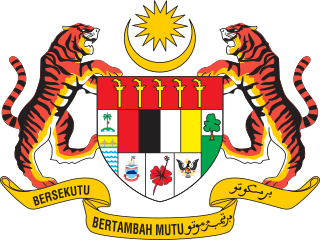Related Research Articles

Pahang, officially Pahang Darul Makmur with the Arabic honorific Darul Makmur is a sultanate and a federal state of Malaysia. It is the third largest Malaysian state and the largest state in peninsular by area, and ninth largest by population. The state occupies the basin of the Pahang River, and a stretch of the east coast as far south as Endau. Geographically located in the East Coast region of the Peninsular Malaysia, the state shares borders with the Malaysian states of Kelantan and Terengganu to the north, Perak, Selangor and Negeri Sembilan to the west, Johor to the south, while South China Sea is to the east. The Titiwangsa mountain range that forms a natural divider between the Peninsula's east and west coasts is spread along the north and south of the state, peaking at Mount Tahan, which is 2,187 metres (7,175 ft) high & the famous Kuantan 188 which is 188 metres (617 ft) high. Although two thirds of the state is covered by dense rain forest, its central plains are intersected by numerous rivers, and along the coast there is a 32-kilometre (20 mi) wide expanse of alluvial soil that includes the deltas and estuarine plains of the Kuantan, Pahang, Rompin, Endau, and Mersing rivers.

Tun Haji Abdul Razak bin Dato' Hussein was a Malaysian lawyer and politician who served as the second prime minister of Malaysia from 1970 until his death in 1976. He also served as the first deputy prime minister of Malaysia from 1957 to 1970. He is referred to as the Father of Development.

Sultan of Pahang is the title of the hereditary constitutional head of Pahang, Malaysia. The current sultan is Al-Sultan Abdullah ibni Sultan Ahmad Shah. He is the Head of Islam in the state and the source of all titles, honours and dignities in the state. Historically, the title was also used by rulers of the Old Pahang Sultanate.
Sultan Muhammad Shah ibni Almarhum Sultan Mansur Shah (1455–1475) was the founder of the old Pahang Sultanate who reigned from 1470 to 1475. A former heir apparent to the Melaka throne, he was banished by his father Mansur Shah for committing murder, following an incident in a Sepak Raga game and went into exile in Pahang, later installed as its first Sultan in 1470.
Sultan Ahmad Shah I ibni Almarhum Sultan Mansur Shah was the second Sultan of Pahang who reigned from 1475 to 1495. He succeeded on the death of his younger brother who was poisoned in 1475. During his reign, relations between Pahang and its Melakan overlord, deteriorated greatly, as a result of his personal resentment towards his half-brother Alauddin Riayat Shah. Under his rule, Pahang became increasingly unstable and he abdicated around 1495, in favour of his son, Raja Mansur.
Sultan Abdul Ghafur Muhiuddin Shah ibni Almarhum Sultan Abdul Kadir Alauddin Shah was the 12th Sultan of Pahang who reigned from 1592 to 1614. He was originally appointed as regent for his younger half-brother of a royal mother, Ahmad Shah II after the death of their father in 1590. He subsequently deposed his charge and assumed power two years later.

The Al-Ghufran Royal Mausoleum is a Royal Mausoleum of Perak located near Ubudiah Mosque at Bukit Chandan in Jalan Istana, Kuala Kangsar, Malaysia. The first Sultan of Perak buried here was Sultan Idris Murshidul Azzam Shah I in 1916.
Sri Paduka Dato' Bendahara Sri Maharaja Tun Ali ibni Almarhum Dato' Bendahara Paduka Raja Tun Koris was the 23rd and the last Bendahara of Johor Sultanate, and the fourth Raja Bendahara of the Pahang Kingdom who reigned from 1806 to 1857.

The Pahang Civil War, also known as the Brothers War or the Bendahara War was a civil war fought from 1857 to 1863, between forces loyal to the reigning Raja Bendahara Tun Mutahir, and forces loyal to his brother Tun Ahmad, over the succession to the throne of Pahang.

Pahang Malays are a sub-group of Malay people native to the state of Pahang, in the east coast of Peninsular Malaysia. With population of approximately 1.08 million people, they constitutes 70% of Pahang state's population, making them the dominant ethnic group in the state. Their language, Pahang Malay is one of many Malayan languages spoken in the region that belong to the Malayo-Polynesian group of Austronesian family.

The Pahang Sultanate also referred as the Old Pahang Sultanate, as opposed to the Modern Pahang Sultanate, was a Malay Muslim state established in the eastern Malay peninsula in 15th century. At the height of its influence, the Sultanate was an important power in Southeast Asian history and controlled the entire Pahang basin, bordering to the north, the Pattani Sultanate, and adjoined to that of Johor Sultanate to the south. To the west, it also extended jurisdiction over part of modern-day Selangor and Negeri Sembilan.

The Pahang Kingdom was a Malay state that existed from 1770 to 1881, and is the immediate predecessor of the modern Malaysian state of Pahang. The kingdom came into existence with the consolidation of power by the Bendahara family in Pahang, following the gradual dismemberment of Johor Empire. A self rule was established in Pahang in the late 18th century, with Tun Abdul Majid declared as the first Raja Bendahara. The area around Pahang formed a part of the hereditary domains attached to this title and administered directly by the Raja Bendahara. The weakening of the Johor sultanate and the disputed succession to the throne was matched by an increasing independence of the great territorial magnates; the Bendahara in Pahang, the Temenggong in Johor and Singapore, and the Yamtuan Muda in Riau.

The Bendahara dynasty is the current ruling dynasty of Pahang, Terengganu and Johor Sultanate, a constituent state of Malaysia. The royal house were of noble origin, holding the hereditary position of Bendahara in the courts of Singapura, Melaka and Old Johor since at least from the end of the 13th century.
Raja Bendahara is a Malay title of monarch ruler in Pahang Kingdom that existed from 1770 to 1881. The title is a combination of the Sanskrit word Raja ('king') and 'Bendahara'. The successive Bendaharas of Johor Empire were ruling Pahang as a fief from the late 17th century. By the end of 18th century, the Bendahara emerged as an absolute ruler over the fief, carrying the title 'Raja', following the decentralisation of Sultan's power and the dismemberment of the empire.
Orang Kaya Indera Pahlawan is a nobility title in Pahang Sultanate and one of the four highest ranking nobles below the monarch. The title traces its origin from the times of the Old Pahang Sultanate, and was historically known as Maharaja Indera Pahlawan. The territory under his jurisdiction is Chenor, and land between the Bera and Kuala Luit.
Orang Kaya Indera Segara is a nobility title in Pahang Sultanate and one of the four highest-ranking nobles below the monarch. The title traces its origin from the times of the Old Pahang Sultanate, and was historically known as Maharaja Indera Putera. The traditional pegangan ('fief') of the nobility is Temerloh, as well as the entire land between the Triang river basin to the borders of Selangor and Rembau in Negeri Sembilan.
Orang Kaya Indera Perba Jelai is a nobility title in Pahang Sultanate and one of the four highest ranking nobles below the monarch. The title traces its origin from the times of the Old Pahang Sultanate, and was historically known as Seri Maharaja Perba. The traditional pegangan ('fief') of the nobility is the land from Tanjung Lindung, the entire Jelai River basin, to the borders of Perak and Kelantan, excluding the Tembeling. It is the largest fief in size and the farthest in distance from the royal court in Pekan, thus making the Maharaja Perba the most powerful among the four major chiefs.
The following is family tree of the Malay monarchs of Pahang, from the establishment of the Old Pahang Sultanate in 1470 until present day.
Few traces remain as to the identity of Terengganu's early rulers. Whats is known is that a trading port was established from as early as the 13th century. Terengganu Inscription Stone attests to the 14th century's first muslim ruler of the state, Raja Mandalika, from the Telanai dynasty. In the late 15th century, the Telanai dynasty came to an end when a Pahang Hulubalang, Sri Akar Diraja, killed Tun Telanai for offending Sultan Ahmad of Pahang. It is believed that Terengganu was later ruled by Sri Akar Diraja's family, before they were eventually replaced by the Megat family.
The Esteemed Order of the Crown of Pahang is a knighthood order of the Sultanate of Pahang.
References
- ↑ Ahmad Sarji Abdul Hamid 2011 , p. 82
- ↑ Linehan 1973 , p. 190
- ↑ Wan Haji Abdul Wahid Bin Haji Wan Hassan 2016
- 1 2 3 Dato' Sri Wan Haji Abdul Wahid. "Pembesar Negeri Pahang: Orang Besar Berempat". Portal Diraja Pahang (in Malay).
- ↑ "Carian Umum". prpm.dbp.gov.my. Retrieved 15 September 2020.
- ↑ Ahmad Sarji Abdul Hamid 2011 , p. 82
- ↑ Linehan 1973 , p. 197
- ↑ Linehan 1973 , p. 196
- ↑ Linehan 1973 , p. 196
- ↑ Linehan 1973 , p. 197
- ↑ Linehan 1973 , p. 197
- ↑ Linehan 1973 , p. 195
- ↑ Linehan 1973 , p. 196
- ↑ Linehan 1973 , p. 195